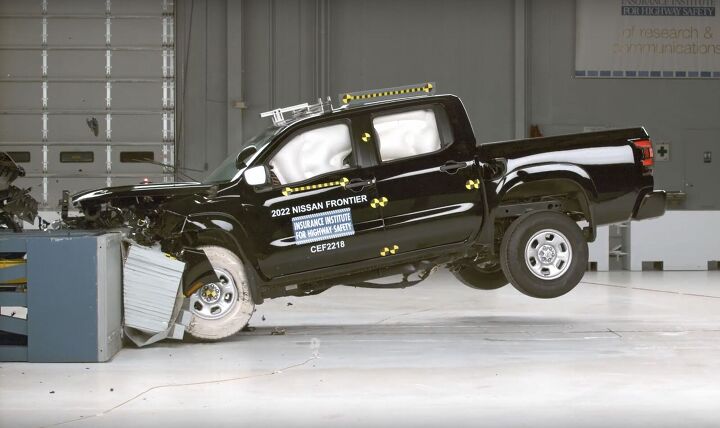
The Insurance Institute for Highway Safety (IIHS) believes that the rear-seat passengers of modestly sized pickups could be better protected after running a few through its updated moderate overlap frontal crash test.
While the group rated the Nissan Frontier as “acceptable,” crew-cabbed versions of the Ford Ranger only garnered a “marginal” classification. That left four-door versions of the Chevrolet Colorado, Jeep Gladiator, and Toyota Tacoma with “poor” ratings. No pickup managed to receive a “good” safety score, with the IIHS highlighting concerns about the possibility of chest, head, and neck injuries.
It likewise expressed general dissatisfaction with the restraint systems in the backs of most midsize crew cabs. However, the group has placed a renewed emphasis on rear-seat safety after having an assessment made on small passenger cars earlier this year.

You should know how the game works by now. The IIHS updates its testing protocols, whips a few automobiles into the wall, and comes to the conclusion that the whole industry needs to improve safety. Manufacturers then make the necessary changes to ensure a desirable score and the whole thing resets after a few years. If we’re lucky, we all end up with slightly safer vehicles that don’t cost or weigh significantly more than their predecessors.
But let’s not pretend like the passenger compartments on pickup trucks haven’t come a long way. Crew cabs haven’t been the norm forever. We used to call them “double cabs” back when regular cabs were actually the regular pickup configuration and typically offered a basic bench seat lacking any kind of shoulder restraints.

Vintage extended cabs (AKA super cabs) were even worse, especially on the smaller models. As a boy, my family briefly owned a Chevrolet S-10 “Maxi-Cab” (pictured above) with inward-facing jump seats. They came exclusively with lap restraints and were positioned so that my skull was guaranteed to bounce between the pickup’s side and rear glass during a collision. It was a novel solution and worked well enough to cram a few extra bodies into the truck with room left over for a couple of shallow cup holders. But it would be considered a death trap by modern standards.
Still, that doesn’t mean we shouldn’t load new models up with dummies before launching them down the runway to see what happens. In the pickup test, the IIHS pulled the vehicles along a 600-foot track so they collided with a barrier with 40 percent of the impact hitting the front of the vehicle at 40 miles an hour. Dummies (the rear one being child-sized) are painted to see where they make contact with the interior and are equipped with sensors that help estimate force. The event is likewise covered by as many cameras as possible, with several being mounted inside the cabin.

“Our updated moderate overlap front crash test proved to be challenging for small pickups,” said IIHS President David Harkey. “A common problem was that the rear passenger dummy's head came dangerously close to the front seatback, and in many cases, dummy measurements indicated a risk of neck or chest injuries. All these things tell us that the rear seat belts need improvement.”
From the IIHS:
All five small pickups provided good protection in the front seat. However, measurements indicated a slightly higher risk of leg or foot injuries to the driver in the Gladiator and Tacoma.
In the Colorado, Frontier, Ranger and Tacoma, the restraints in the back seat allowed the rear dummy’s head to come too close to the front seatback. That was not an issue for the Gladiator. However, its rear restraints do not include a side curtain airbag, increasing the risk of injury from a hard impact with the interior of the vehicle or even something outside it.
In the Ranger, the rear dummy submarined beneath the lap belt, causing it to ride up from the ideal position on the pelvis onto the abdomen, which increases the risk of internal injuries.
Otherwise, injury measures taken from the rear dummy indicated a moderate or likely risk of both neck and chest injuries in the poor-rated Colorado, Gladiator and Tacoma and a moderate risk of chest injuries in the marginal-rated Ranger.
So far, the IIHS has tested a handful of popular cars and 28 crossovers/SUVs under its new testing protocols.

The vast majority of those vehicles failed to earn a coveted “good” safety rating. Only the Ford Explorer, Ford Mustang Mach-E, Ford Escape, Subaru Ascent, Tesla Model Y, and Volvo XC40 passed with full marks. However, it should be noted that the IIHS has not run every vehicle currently on sale and will definitely have some blind spots. Testing every single model and trim is time-consuming and ultimately unrealistic, so it’s on you to do some of your own research.
That said, the group seems very keen on having manufacturers update their rear restraint systems and appears to be focusing on the issue like it previously did with headlight glare. This is likely to remain the organization's main focus for the next couple of years.
A detailed breakdown of the individual midsize pickup safety ratings is available at the Insurance Institute for Highway Safety's website and we're providing links to relevant crash test footage for the Chevrolet Colorado, Ford Ranger, Jeep Gladiator, Nissan Frontier, and Toyota Tacoma here.

[Images: IIHS; General Motors]
Become a TTAC insider. Get the latest news, features, TTAC takes, and everything else that gets to the truth about cars first by subscribing to our newsletter.
from TheTruthAboutCars https://www.thetruthaboutcars.com/cars/news-blog/iihs-says-midsize-pickups-need-more-passenger-protection-44501644?utm_medium=auto&utm_source=rss&utm_campaign=all_full
No comments:
Post a Comment